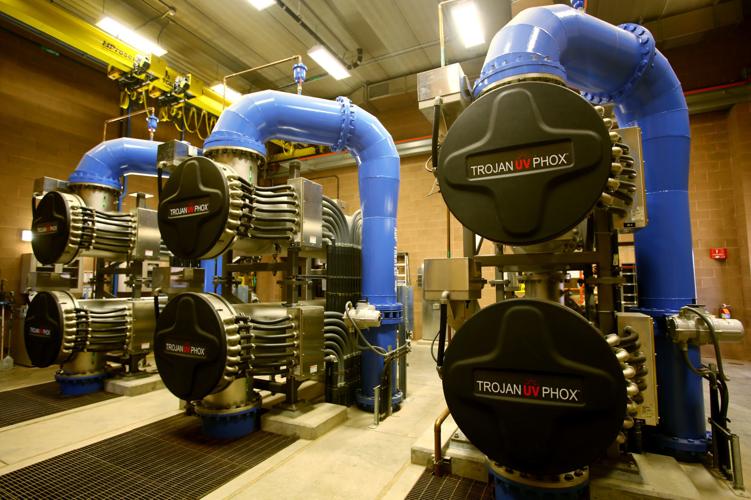Tucson wants the EPA to let it off the legal hook for serving its customers once-tainted water cleaned by a south-side treatment plant.
Tucson Water is negotiating with the Environmental Protection Agency to amend an old agreement that requires the city to serve more than 5,800 acre-feet of water annually cleaned by its plant near the Interstate 19-Irvington Road interchange. That is enough water to serve more than 20,000 Tucson homes per year.
The City Council voted Jan. 7 to support the amendment effort, through negotiations that actually began in September.
A key reason is to insure the city is never required to sell customers water from the Tucson Airport Remediation Project, or TARP, in the event the plant is overloaded by toxic PFAS compounds. The compounds, in very heavy concentrations, are now slowly migrating through the aquifer toward south-side wells that already send water with lesser PFAS levels to the plant for cleanup.
In a related matter, the city is putting off suing to force cleanup of its PFAS-tainted groundwater by the U.S. Defense Department and other parties for their alleged role in the pollution. Instead, by a unanimous City Council vote on Jan. 7, city officials will seek to negotiate a cleanup with EPA, the state, the Defense Department and other parties, Mayor Regina Romero said. Litigation will be left in reserve as a “hole card” to use in case negotiations don’t work, council members said.
The City Council is also partially backing off from an earlier move directing the City Attorney’s Office to prepare a proposed ordinance banning anyone from using or disposing of PFAS compounds within the city.
Attorneys determined the city can’t legally ban use of PFAS by federal entities such as the Defense Department, so the council will now concentrate on getting legislation to stop anyone from dumping PFAS compounds into the ground.
The city will also try to work with Pima County wastewater officials to seek a ban on disposal of such materials into the county sewer system. All these measures are connected with the ongoing concern by city officials and many residents about the severe contamination of Tucson’s south-side groundwater by PFAS compounds.
The success of some of the city’s efforts will also rest on the success of efforts by Tucson officials — and officials of numerous other cities nationwide — to prod a reluctant federal government to clean up PFAS groundwater pollution linked to hundreds of military facilities.
Romero and Assistant City Attorney Chris Avery said they’re confident cleanup money will become available through a series of bills and regulatory efforts now moving through the federal government, but Councilman Steve Kozachik is less optimistic.
In Tucson, PFAS chemicals have been found in wells lying north of the Air National Guard base here, and east of city wells supplying the south-side treatment plant, at concentrations up to 13,000 parts per trillion. Just last week, the Arizona Department of Environmental Quality reported that eight nearby private wells had measurable PFAS, topped by an irrigation well containing 11,440 parts per trillion and two drinking wells with 2,300 and 1,300 parts per trillion.
These concentrations far exceed EPA’s recommended health advisory level of 70 parts per trillion for lifetime exposure, let alone Tucson Water’s goal of reducing PFAS concentrations to 18 parts per trillion tops.
The compounds are linked to testicular and kidney cancer and to developmental delays in fetuses and children, decreased fertility, changes to the immune system and increased asthma risks.
But to date, those high levels haven’t found their way into city wells serving drinking water to people, since water from the aquifer holding the contaminants hasn’t been served to the public for decades.
Requirement dates back to TCE woes
The requirement that the city serve water from the treatment plant dates back to long before PFAS was even heard of — to a 1988 consent order that the city and EPA signed for the plant.
That order was designed to insure removal from south-side groundwater of the common industrial solvent trichloroethylene, or TCE, that polluted numerous drinking wells in the 1970s.
The order said, “Treated water will be fed directly into the municipal distribution system.”
Today, Romero, Avery and Kozachik agreed that a consent-order change is needed in case of what they think, or hope, is the unlikely scenario that the PFAS compounds overload the TARP plant before officials can raise money to clean the groundwater.
Since lower levels of PFAS contamination were discovered in wells serving the TARP plant, the city has repeatedly changed its carbon filters to provide more effective treatment at a cost of $1.75 million.
If the higher concentrations ever reach the plant, “it could become really problematic to keep changing out the filters,” said Kozachik, the first council member to push for cleanup of this water. “We want other options on the table.”
Romero agreed the amended order is needed “in case we don’t get the water treated to levels that are acceptable to the mayor and council and Tucson Water.”
They and Avery said they don’t know what the city would do with the heavily tainted groundwater if money isn’t found to clean it to acceptable concentrations.
But Romero and Avery said they don’t expect it to come to that because they think cleanup money will become available first.
The city also doesn’t need to serve the treated TARP water to customers today because it already has a surplus of available supplies without that water, Avery said.
The city today buys 144,000 acre-feet of Central Arizona Project water annually but is able to recharge nearly one-third of that because its total, annual potable water use is 100,000 acre-feet.
The EPA didn’t directly respond to a question from the Star seeking its views on amending the 1988 consent order. In a statement sent by email, the agency said, “We are working with the State of Arizona, the City, and others to evaluate and address the identified areas of PFAS groundwater contamination. We aim to effectively capture and clean up groundwater contamination at the site to protect public health and the environment.”
Similarly, the Arizona Department of Environmental Quality says it's collaborating with a long list of agencies "to explore options to address PFAS groundwater contamination" near the south side Superfund toxic waste cleanup site centered at Tucson International Airport. The agencies include EPA, the Arizona Department of Emergency and Military Affairs, the Arizona National Guard, DoD, the Pima County Department of Environmental Quality, Pima County Department of Health Services, and Tucson Water. This collaboration will include examining opportunities for Department of Defense assistance, as outlined in the new national defense bill, ADEQ spokeswoman Erin Jordan said.
Funding uncertain
Today, it’s highly uncertain when and how much cleanup money will come to the city. City officials don’t have a firm estimate of a cleanup cost other than it’s likely to be tens of millions of dollars.
Last month, Congress passed and President Trump signed the National Defense Authorization Act. It contains provisions requiring the Defense Department to negotiate PFAS cleanup agreements with individual cities and pay for the cleanup itself. First, the governor of the state in which that contamination lies must request negotiations.
The law doesn’t appropriate cleanup money. But it allows the department to dip into its other pots of cleanup funds for PFAS cleanups, said Monica Matoush, a House Armed Services Committee spokeswoman. Before, the department couldn’t use cleanup funds for Air National Guard facilities.
In a statement, the Arizona National Guard, which operates the base underneath which PFAS contamination has been found, said the department hasn’t established a formal mechanism for funneling funds into individual cleanups.
“However, the DOD has made it clear that its first priority will be to support communities whose drinking water is affected. In the meantime, the Arizona National Guard is working with the state to anticipate the process to acquire those funds,” the guard statement said.
ADEQ said in a statement that its collaborations with other agencies will include examining opportunities for Department of Defense assistance, as outlined in this newly passed bill.
Staff for the House Energy and Commerce Committee was more skeptical about how effectively the defense act will promote PFAS cleanups in cities.
In general, the department “has been refusing to do those cleanups. A few states have been trying, but the DOD has told them they won’t do the cleanup,” said a committee staff member who wasn’t authorized to be quoted by name.
A more stringent bill with more specific assurances of PFAS cleanup funds passed the House on Jan. 10 by 249-157 vote. The PFAS Action Act, backed by Romero, would require legally classifying PFAS as a hazardous substance.
That would free up federal Superfund toxic waste funds to clean the contaminated water in Tucson and other cities, with polluters being required to ultimately pay up if they’re still around.
The bill also contains $200 million for PFAS cleanups nationally over two years. But the Trump administration opposes the bill as an intrusion over its agencies’ authority to decide how to regulate pollutants.
Kozachik said what’s needed is a federal drinking water standard for the chemical. It would force the military to clean it to acceptable levels, but EPA has delayed a decision on whether to set a standard.





